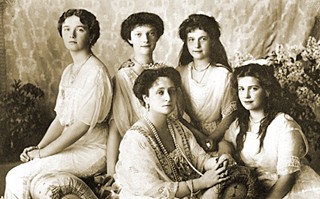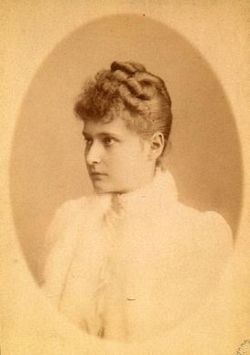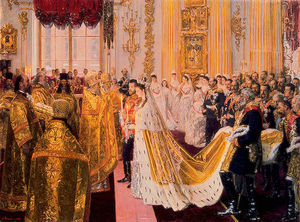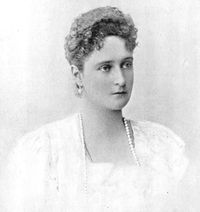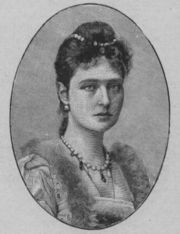Alexandra Fyodorovna of Hesse
Princess Alix of Hesse and by Rhine (German: Victoria Alix Helene Luise Beatrice Prinzessin von Hessen und bei Rhein) or Saint Alexandra, 6 June 1872 – 17 July 1918, under the title Empress Alexandra Fyodorovna (Russian: Императрица Александра Фёдоровна), was Empress consort of Russia. She was the wife of Nicholas II of Russia, the last Tsar. She was a granddaughter of Queen Victoria. Although born Alix – a German version of her mother's name, Alice – she assumed the name Alexandra Fyodorovna upon blessing into the Russian Orthodox Church.
Alexandra is remembered as the last Tsaritsa of Russia, as one of the most famous genetic carriers of hemophilia, as well as for her support of authoritarian control over the country. Her relationship with the Russian mystic Grigori Rasputin was also an important factor in her life.
Early life
Princess Alix of Hesse and by Rhine was born in Darmstadt in Hesse (then part of the German Empire). Her father was Ludwig IV, Grand Duke of Hesse and by Rhine. Her mother was Princess Alice of the United Kingdom, the second eldest daughter of Queen Victoria and of Prince Albert of Saxe-Coburg-Gotha. She was baptized on 1 July 1872 according to the rites of the Lutheran Church and given the names of her mother and each of her mother's four sisters. Her godparents were The Prince of Wales, The Princess of Wales, The Tsarevich of Russia, The Tsarevna of Russia, Princess Beatrice of the United Kingdom, The Duchess of Cambridge, and The Landgravine of Hesse.
In 1878 when Alix was six, her mother died. She became very close to her grandmother, Queen Victoria, and was often thought to be Victoria's favourite granddaughter. Alix spent much of her early years in the United Kingdom, and frequently stayed with her English relatives at Balmoral Castle in Scotland and at Osborne House on the Isle of Wight. As a little girl, she was called Sunny. But after the loss of her mother and younger sister, May, she became more sullen and withdrawn. In 1892 when Alix was twenty, her father died. Her brother, Ernst Ludwig, succeeded his father as Grand Duke of Hesse and by Rhine.
Marriage
Alexandra was married relatively late for her rank in her era, having refused a proposal from Prince Albert Victor, Duke of Clarence (the eldest son of the Prince of Wales) despite strong familial pressure. She had, however, already met a distant cousin, the Tsarevich of Russia. At first, Nicholas's father, Tsar Alexander III, refused the prospect of marriage, but later relented as his health began to fail. Alexandra was troubled by the requirement she renounce her Lutheran faith, as a Russian Tsarina had to be Orthodox; but she was persuaded and eventually became a fervent, even fanatic convert. She and Nicholas became engaged in April 1894. Alexander III died in November of that year, and Nicholas became Tsar of all the Russias at the age of twenty-six.
Alix of Hesse accompanied the Imperial family as they returned to St. Petersburg with the body of the Tsar, and it is said that the people greeted their new Empress-to-be with ominous whispers of "She comes to us behind a coffin".
Alexandra and Nicholas married on November 26, 1894 at the Winter Palace in St. Petersburg, Russia. They had five children:
- Grand Duchess Olga of Russia, (November 15, 1895 - July 17, 1918)
- Grand Duchess Tatiana of Russia, (June 10, 1897 - July 17, 1918)
- Grand Duchess Maria of Russia, (June 26, 1899 - July 17, 1918)
- Grand Duchess Anastasia of Russia, (June 18, 1901 - July 17, 1918?)
- Tsarevich Alexei of Russia, (August 12, 1904 - July 17, 1918)
Unfortunately, Alexandra was a carrier of haemophilia, inherited from Queen Victoria through her mother, Princess Alice. Alexandra transmitted the disease to her son, Alexei.
Empress Alexandra
On May 14th 1896, Nicholas and Alexandra were crowned Emperor and Empress of Russia in Moscow. The coronation celebrations was marred by the deaths of several thousand peasants in the Khodynka Tragedy, who had come to receive gifts. This bad omen for the reign of Nicholas and Alexandra did not go unnoticed.
Alexandra was unpopular at court and with the Russian people, lacking charm and social skills. She was hurt by their unenthusiastic reception, and declared herself to be tired of the loose morals and etiquette of the Russian court. She did not attempt to forge bonds with the other members of the large Romanov family and she generally attended as few court occasions as possible. She was unfavourably compared to her popular (and still youthful) predecessor, The Dowager Empress Maria Feodorovna, daughter of King Christian IX of Denmark and a sister of the Princess of Wales, who had a higher court precedence. In Russia, Dowager Empresses outranked Empress Consorts, unlike at most royal courts of Europe. This was not conducive to happy family relations. Her failure to produce an heir to the Russian throne in her first four attempts was also judged harshly.
Alexandra was fiercely protective of her husband's role as Tsar, and actively supported his rights as an autocratic ruler. She was a fervent advocate of the divine right, and believed that it was unnecessary to attempt to secure the approval of the people.
Rasputin
The birth of Alexei occurred at the height of the Russo-Japanese War on August 12, 1904. The Tsarevitch was the Heir Apparent to the throne of Russia, and Alexandra had fulfilled her most important role as Tsarina, in bearing a male child. The excitement was short-lived, when it was discovered Alexei suffered from haemophilia, which could only have been transmitted from Alexandra's side of the family. Haemophilia was generally fatal in the early 20th century, and had entered the royal houses of Europe via the daughters of Queen Victoria, who was a carrier. Alexandra had lost a brother to the disease, as well as an uncle, Prince Leopold, Duke of Albany; it also spread to the Spanish and Prussian royal families, via other granddaughters of Queen Victoria. As an incurable and life threatening illness, suffered by the sole male heir, the heir's disease was kept secret from the Russian people.
At first Alexandra turned to Russian doctors and medics to treat Alexei; however, their treatments generally failed, and Alexandra increasingly turned to mystics and holy men. One of these, Grigori Rasputin, appeared to have a success still inexplicable today. Rasputin's unpopularity, however, and the dark rumours about him led Nicholas to distance him from the family. In 1912, Alexei suffered a life-threatening haemorrhage in the thigh and groin while the family were at Spala, Poland. At this point Alexandra took the advice of her intimate friend Anna Vyrubova and sent a telegram to Grigori Rasputin. Rasputin's response, that Alexei was over the worst and the doctors should leave him to recover, coincided with his revival. From 1912 onwards, Alexandra came to rely increasingly on Rasputin, and to believe in his ability to ease Alexei's suffering. This reliance enhanced Rasputin's political power, which was to critically undermine Romanov rule during the First World War.
World War One
The outbreak of World War I was a pivotal moment for Russia and Alexandra. The war pitted the Russian Empire of the Romanov dynasty against the German Empire of the Hohenzollern dynasty. The Grand Duchy of Hesse and by Rhine, ruled by her brother, formed part of the German Empire. This was of course the place of Alexandra's birth. This made Alexandra very unpopular with the Russian people, who accused her of collaboration with the Germans. The German Kaiser, William II, was also Alexandra's first cousin. Ironically, one of the few things that Empress Alexandra and her mother-in-law Empress Marie had in common was their utter distaste for Kaiser Wilhelm II.
When the Tsar travelled to the front line in 1915 to take personal command of the Army, he left Alexandra in charge of St. Petersburg. Alexandra was not gifted at government, and constantly appointed and reappointed new ministers, which meant the government was never stable nor efficient. This was particularly dangerous in a war of attrition, as neither the troops nor the civilian population were ever adequately supplied. She paid great attention to the self-serving advice of Rasputin, and their relationship was widely (and inaccurately) believed to be sexual in nature. She was the focus of ever increasing and extremely negative rumours, and widely believed to be a German spy in the Russian court. Rasputin was eventually murdered by junior members of the Romanov family Grand Duke Dmitri Pavlovich and Prince Felix Yusupov, who was married to the Tsar's niece Princess Irina (daughter of Grand Duchess Xenia Alexandrovna and Grand Duke Alexander Mikhailovich) in 1916.
Alexandra's relationship with the Tsar was loving but extremely manipulative and controlling, and he backed her against the strongly voiced complaints of the Romanov family.
Revolution
Russia crashed out of World War I in 1917, and the February Revolution that followed, forced the Tsar to abdicate the throne both for himself and the Tsarevich Alexei. Alexandra was now in a perilous position as the wife of the deposed Tsar, hated by the Russian people. Despite the fact he was a cousin of both Alexandra and Nicholas, King George V refused to allow them to evacuate to the UK, as he was alarmed by their unpopularity in his country and the potential repercussions on his own throne.
The Provisional Government formed after the revolution kept Nicholas, Alexandra and their children confined in their primary residence, the Alexander Palace at Tsarskoye Selo, until they were moved to Tobolsk in Siberia in August 1917, a step by the Kerensky government designed to remove them from the capital and possible harm. They remained in Tobolsk until after the Bolshevik Revolution in November 1917, but were subsequently moved to Red-controlled Yekaterinburg. The Tsar and Tsaritsa and all of their family, including the gravely ill Alexei, along with several family servants, were executed by firing squad in the basement of the Ipatiev House, where they had been imprisoned, on the night of July 16 (or 17), 1918, by a detachment of Bolsheviks led by Yakov Yurovsky.
Identification and burial
After the brutal murder of the Romanov family in the Ipatev House, Alexandra's body, along with Nicholas, their children and some faithful retainers who died with them, was stripped and the clothing burnt according to the Yurovsky Note. Initially the bodies were thrown down a disused mine-shaft, 12 miles north of Yekaterinburg. A short time later they were retrieved, their faces were smashed and the bodies dismembered and disfigured with sulphuric acid were hurriedly buried under railway sleepers with the exception of two of the children whose bodies have still not been located. The bodies missing are assumed to be those of Anastasia and Alexis. In the early 1990s, following the fall of the Soviet Union, the presumed bodies of the majority of the Romanovs were located along with their loyal servants, exhumed and formally identified. A secret report by Yurovsky, which came to light in the late 1970s, but did not become public knowledge until the 1990s, helped the authorities to locate the bodies.
DNA analysis was a key means of identifying them. A blood sample from Prince Philip, Duke of Edinburgh (a grandson of Alexandra's oldest sister, Princess Victoria of Hesse and the Rhine) was used to identify Alexandra and her daughters through their mitochondrial DNA. They belonged to Haplogroup H (mtDNA). Nicholas was identified from DNA obtained from among others his late brother Grand Duke George Alexandrovich of Russia. Grand Duke George had died of tuberculosis in the late 1890s and was buried in the Peter and Paul Fortress in St.Petersburg. Alexandra, Nicholas and their children (except Alexei and one daughter, Maria Grand Duchess of Russia, whose remains were missing) were reinterred in the Romanov family crypt in the Peter and Paul Cathedral in 1998, with much ceremony, on the 80th anniversary of the execution. The Russian Orthodox Church does not acknowledge the remains as the Romanovs because of the absence of Nicholas's saber wound and recent challenges. DNA testing done on the alleged remains of the most famous Grand Duchess Anastasia imposter, Anna Anderson, proved that she was a Polish factory worker (although her supporters question this). Most people accept that the entire Imperial family was executed on that terrible night of July 17, 1918.
In 2000 Alexandra was canonised by the Russian Orthodox Church together with her husband Nicholas II, their children, and other selected members of the Romanov dynasty.
A rather romantic version of her life was dramatized in the 1971 movie Nicholas and Alexandra - based on the book by the same title written by Robert Massie], in which she was played by Janet Suzman.
Titles
- Her Grand Ducal Highness Princess Alix of Hesse and by Rhine
- Her Imperial Highness Grand Duchess Alexandra Fyodorovna of Russia (created prior to marriage)
- Her Imperial Majesty Empress Alexandra Fyodorovna of Russia
